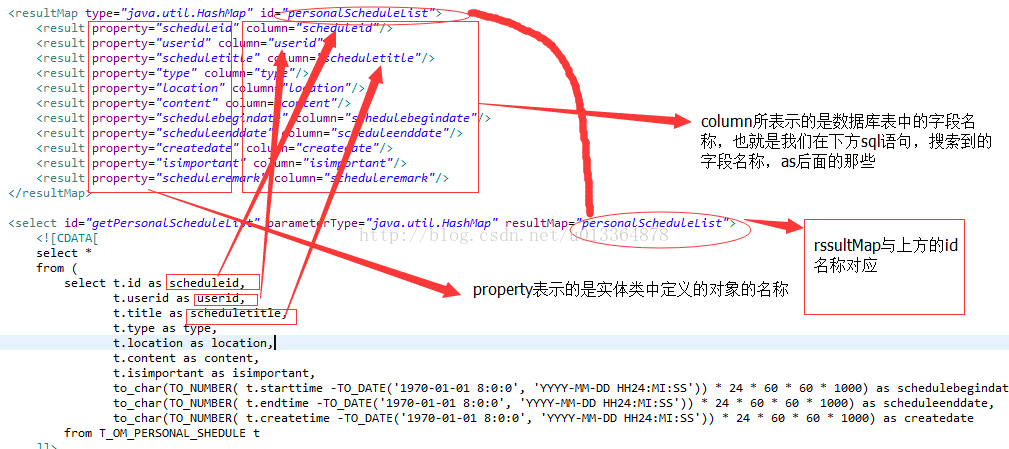在Mybatis的配置中,标签有非常多的属性,其中ResultMap的标签尤其令我头疼,故写一篇随笔来简单解释一下ResultMap。
1 <?xml version="1.0" encoding="UTF-8"?> 2 <!DOCTYPE mapper 3 PUBLIC "-//mybatis.org//DTD Mapper 3.0//EN" 4 "http://mybatis.org/dtd/mybatis-3-mapper.dtd"> 5 <mapper namespace="com.how2java.pojo"> 6 <resultMap type="Category" id="categoryBean"> 7 <id column="cid" property="id" /> 8 <result column="cname" property="name" /> 9 10 <!-- 一对多的关系 --> 11 <!-- property: 指的是集合属性的值, ofType:指的是集合中元素的类型 --> 12 <collection property="products" ofType="Product"> 13 <id column="pid" property="id" /> 14 <result column="pname" property="name" /> 15 <result column="price" property="price" /> 16 </collection> 17 </resultMap> 18 19 <!-- 关联查询分类和产品表 --> 20 <select id="listCategory" resultMap="categoryBean"> 21 select c.*, p.*, c.id 'cid', p.id 'pid', c.name 'cname', p.name 'pname' from category_ c left join product_ p on c.id = p.cid 22 </select> 23 </mapper>
上面对Category的配置中,可先看到select标签,id属性用于后台进行调用:

1 public static void main(String[] args) throws IOException { 2 String resource = "mybatis-config.xml"; 3 InputStream inputStream = Resources.getResourceAsStream(resource); 4 SqlSessionFactory sqlSessionFactory = new SqlSessionFactoryBuilder().build(inputStream); 5 SqlSession session=sqlSessionFactory.openSession(); 6 7 List<Category> cs=session.selectList("listCategory"); 8 for (Category c : cs) { 9 System.out.println(c.getName()); 10 } 11 12 }
而其中的resultmap属性则为重点,其实select标签有两种result属性:
resultType:从这条语句要返回的期望类型的类的完全限定名或别名(这里注意下集合类型,应该是集合可以包含的类型,不能是集合本身),重要:使用resultType或resultMap,但不能同时使用。
resultMap:命名引用外部的resultMap,其名称要和外部的resultMap元素的ID名称一致,用于映射其结果到实体类指定对象中。
而这两种属性的使用场景如何呢?
一般,当我们需要查询一整张表时,我们我就会用到resultType,这时mybatis会自动创建一个resultMap,直接映射到对应的JavaBean之上。
而要用到resultMap时,则需要写出如上所示的resultMap标签。
selet标签还有一个属性,parameterType属性,即参数类型属性,该属性用于表明sql中传递参数的类型。
parameterType属性现在可以使用的有两种:
1.基本数据类型:如int,String等,作为基本数据类型只能传入一个,通过#{参数名}获取。
2.复杂数据类型:包括Java实体类、Map,通过#{属性名}或#{Map的KeyName}获取。
上面两种情况如下所示
<delete id="deleteCategory" parameterType="Category" > delete from category_ where id= #{id} </delete> <select id="getCategory" parameterType="_int" resultType="Category"> select * from category_ where id= #{id} </select>
对于resultMap标签,它具有id和type属性,id属性代表其表示,type属性则表示其映射的类。
其还具备两个子标签:id:表示主键,作为唯一标识。result:表示属性。
property:实体类中定义对象的名称,用于映射数据库列的字段与属性。
column:数据库中的字段名,和property对应。
从其他博客中看到一张图片能图较清晰的明了这其中的关系。

来源:https://blog.csdn.net/u013364878/article/details/78658232?utm_source=blogxgwz0
